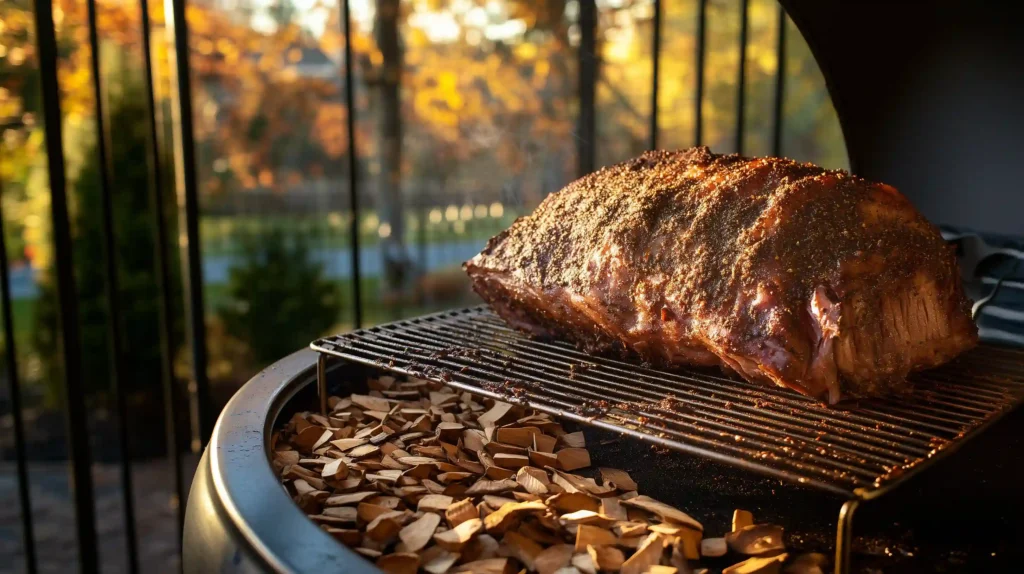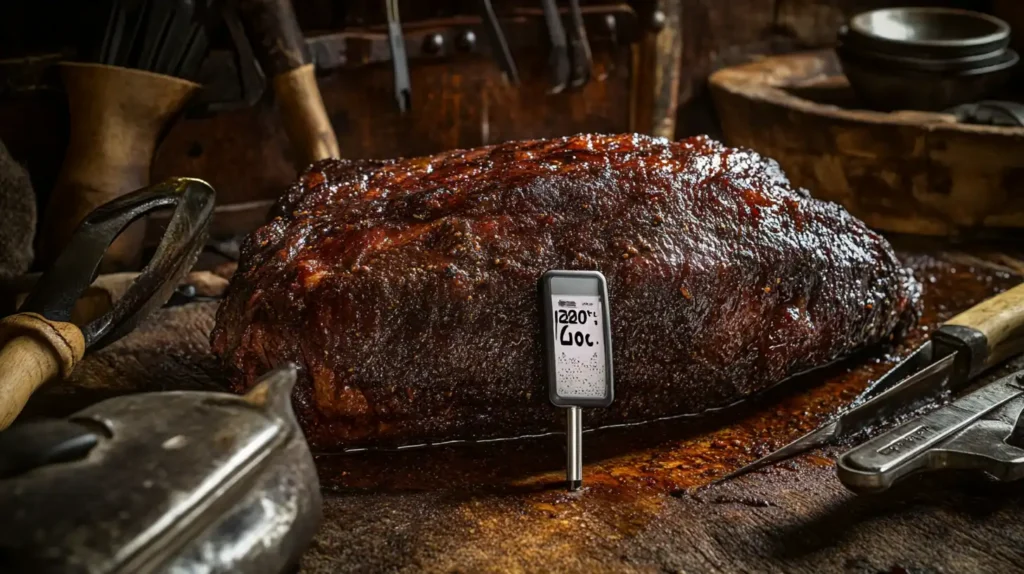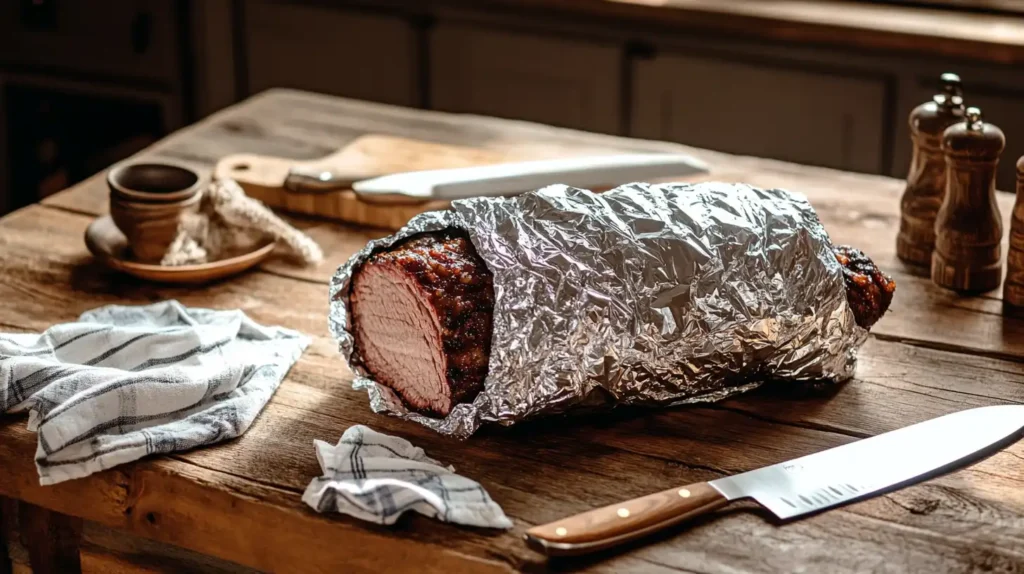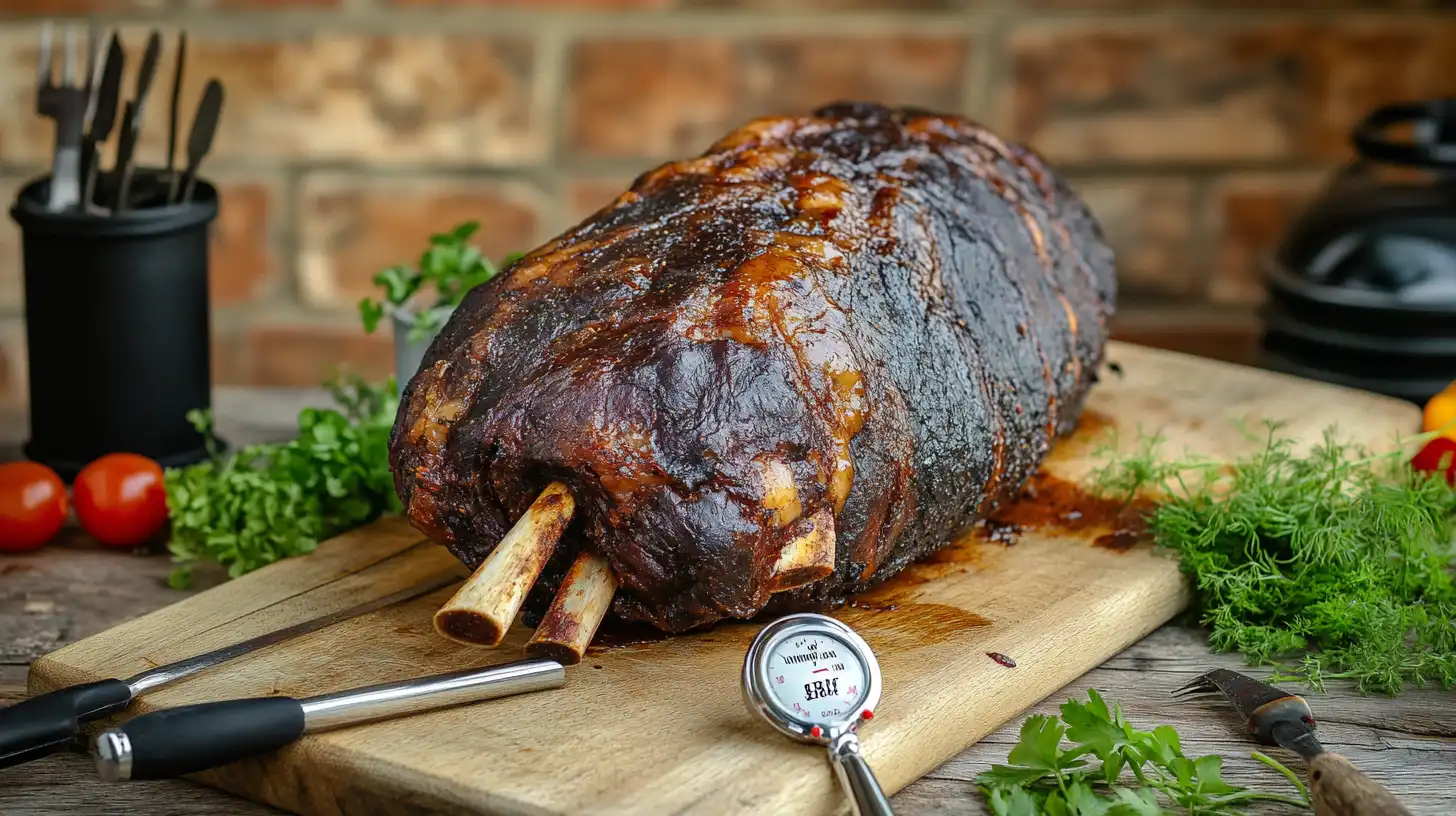Introduction
Smoking brisket to perfection requires time, patience, and the right techniques. But the most common question for barbecue enthusiasts is, “How long to smoke brisket?” The cooking process is low and slow, but the exact time depends on several factors.
In this guide, we’ll explain how long to smoke brisket, covering general guidelines, tips for success, and key factors like smoker temperature and brisket size. Whether it’s your first attempt or you’re perfecting your technique, this guide will help you achieve tender, flavorful brisket every time.
Factors That Affect Smoking Time
Size and Weight of the Brisket
The size and weight of the brisket play a major role in how long it needs to smoke. Smaller briskets, weighing around 8–10 pounds, take less time than larger cuts over 15 pounds. As a rule of thumb, plan for 1–1.5 hours of smoking per pound at 225°F–250°F (107°C–121°C).
For instance, a 10-pound brisket might need 10–15 hours, while a 15-pound cut can take 18 hours or more. Keep the brisket size in mind when planning your cooking time to ensure you have enough time to finish properly.
Smoker Temperature
The temperature of your smoker greatly affects how long it takes to smoke a brisket. Most people stick to 225°F (107°C), the “low-and-slow” standard. This temperature allows the brisket to cook evenly and tenderize as connective tissues break down. If you choose to smoke at 250°F (121°C), the cooking process will be faster, but you’ll need to watch it more closely to avoid drying out the meat.
Some prefer smoking at 275°F (135°C) for an even quicker cook. While this method saves time, it demands extra attention to prevent overcooking. No matter what temperature you choose, keeping it steady is the key to success.
Fat Content and Marbling
The fat content and marbling in your brisket also affect smoking time. Briskets with more marbling, or intramuscular fat, cook more slowly. The fat breaks down gradually, keeping the meat moist and flavorful. Leaner briskets cook faster but are more prone to drying out.
When buying brisket, look for a nice fat cap and good marbling throughout. These traits help the brisket stay moist while enhancing flavor. They also influence how long the smoking process will take.
Desired Doneness or Texture
Your preferred doneness or texture also impacts the cooking time. Most brisket enthusiasts aim for “probe tender.” This means a skewer or thermometer should slide into the meat easily. This usually happens when the internal temperature reaches 200°F–205°F (93°C–96°C).
If you like a firmer texture, pull the brisket off the smoker at 195°F (90°C). However, for classic brisket with melt-in-your-mouth tenderness, wait until it reaches the higher range.

General Smoking Guidelines
Smoking Brisket at 225°F–250°F: The Gold Standard
Most barbecue experts recommend smoking brisket at a consistent temperature between 225°F and 250°F (107°C–121°C). This range, often referred to as the “gold standard,” ensures the brisket cooks evenly and becomes tender without drying out. The lower temperature allows the collagen and connective tissues in the meat to break down slowly, creating that melt-in-your-mouth texture brisket lovers crave.
Keeping the temperature steady is crucial, as fluctuations can result in uneven cooking. Use a reliable smoker with good temperature control, or invest in an external thermometer for accuracy. Remember, brisket is all about patience. Low-and-slow cooking might take time, but the results are worth it.
How Long Per Pound?
As a general rule, you should plan to smoke your brisket for 1–1.5 hours per pound at 225°F (107°C). For example, a 10-pound brisket will take roughly 10–15 hours to cook. However, this time can vary depending on factors like the cut’s thickness, marbling, and your desired doneness.
Rather than relying solely on time, focus on the internal temperature of the brisket. Use a meat thermometer to check when the brisket reaches the optimal range of 200°F–205°F (93°C–96°C). While time gives you a rough estimate, the internal temperature ensures precision.
Wrapping the Brisket: Does It Impact Cooking Time?
Wrapping the brisket during smoking, often referred to as the “Texas Crutch,” can significantly impact cooking time. This technique involves wrapping the brisket in foil or butcher paper once it reaches an internal temperature of around 160°F (71°C). Wrapping helps the brisket retain moisture, prevents it from drying out, and speeds up the cooking process by allowing the meat to cook in its own juices.
Foil wrapping is great for locking in moisture, but it can soften the bark (the outer crust). Butcher paper, on the other hand, lets the meat breathe while maintaining some bark texture. Both methods help you push through the “stall”—a phase where the brisket’s internal temperature plateaus, slowing the cooking process. Using the Texas Crutch can shave an hour or two off your total smoking time while ensuring a juicy, flavorful brisket.
Tips for Perfectly Smoked Brisket
Using a Meat Thermometer to Monitor Internal Temperature
A meat thermometer is essential for smoking brisket. It removes the guesswork and ensures your brisket is cooked to perfection. Insert the thermometer into the thickest part of the meat, avoiding any bones, for the most accurate reading. Aim for an internal temperature of 200°F–205°F (93°C–96°C) for tender, juicy brisket.
If you don’t have a thermometer yet, consider investing in a digital or wireless model. These tools allow you to monitor the temperature without constantly opening the smoker, which helps maintain consistent heat. Experiment with techniques outlined in Why is My Smoked Chicken Rubbery? for perfect results.

Resting the Brisket After Smoking
Resting your brisket is just as important as the smoking process itself. After the brisket reaches the desired temperature, remove it from the smoker and wrap it tightly in foil or butcher paper. Let it rest for at least 30 minutes, or up to an hour, in a cooler or warm oven. This step allows the juices to redistribute throughout the meat, ensuring every bite is tender and flavorful. For detailed smoker recipes, visit Smoker Recipes.
Skipping the resting phase can result in dry brisket, as the juices will escape when you slice it too soon. Patience pays off here, so give the brisket time to settle before serving.

Maintaining Consistent Temperature During Smoking
Maintaining a consistent smoker temperature is critical for perfectly smoked brisket. Fluctuations in heat can cause uneven cooking and extend the overall smoking time. To prevent this, use a smoker with reliable temperature controls or keep an eye on your smoker’s built-in thermometer.
If you’re using a charcoal or wood smoker, learn how to manage the airflow and fuel supply to maintain steady heat. Adding small amounts of charcoal or wood chips at regular intervals can help keep the temperature consistent. Avoid opening the smoker lid too often, as each time you do, you’ll lose valuable heat and slow down the cooking process.
Create a complete meal by serving smoked meats with dishes like Balthazar Beet Salad for a refreshing contrast to smoky flavors.
Frequently Asked Questions
How Do I Know When My Brisket Is Done?
The best way to know if your brisket is done is by checking its internal temperature. Brisket is considered perfectly cooked when it reaches an internal temperature of 200°F–205°F (93°C–96°C) in the thickest part of the meat. Use a reliable meat thermometer to check the temperature without cutting into the brisket, which can release the juices prematurely.
In addition to the temperature, many pitmasters use the “probe test” to determine doneness. Insert a skewer, thermometer probe, or fork into the meat; it should slide in and out easily, like butter, when the brisket is fully cooked. This is often referred to as being “probe tender.” Combining temperature checks with the probe test ensures a perfectly cooked brisket.
Can I Smoke Brisket at Higher Temperatures to Save Time?
Yes, you can smoke brisket at higher temperatures, but it requires extra care. This method, often called “hot and fast,” involves smoking at 275°F–300°F (135°C–149°C) instead of the traditional 225°F (107°C). While it can reduce cooking time significantly, you’ll need to monitor the brisket closely to avoid overcooking or drying it out.
The hot and fast method is great for experienced smokers or those short on time, but beginners may find it more challenging. If you try this approach, wrapping the brisket in foil or butcher paper during the cooking process can help retain moisture and prevent the meat from drying out. Remember, while it’s faster, the low-and-slow method remains the gold standard for achieving that perfect, tender brisket texture.
How Long Should Brisket Rest After Smoking?
Resting your brisket is a crucial step that shouldn’t be skipped. After removing it from the smoker, let the brisket rest for at least 30 minutes, but ideally up to 1–2 hours. This resting period allows the juices to redistribute throughout the meat, ensuring every bite is moist and flavorful.
To keep the brisket warm while it rests, wrap it tightly in foil or butcher paper and place it in a cooler lined with towels. This method, sometimes called a “faux cambro,” keeps the brisket warm without continuing to cook it. Properly rested brisket is easier to slice and will have a better texture overall.
Why Does My Brisket Stall During Smoking?
The brisket stall is a common phenomenon that happens when the internal temperature of the meat plateaus, usually around 150°F–170°F (65°C–76°C). This occurs because the meat’s surface moisture evaporates, cooling the brisket and slowing down the cooking process. While the stall can be frustrating, it’s a normal part of smoking brisket and often lasts 1–2 hours.
To push through the stall, many pitmasters use the “Texas Crutch” technique, which involves wrapping the brisket in foil or butcher paper. Wrapping traps the moisture and heat, helping the brisket cook more quickly through the stall. Alternatively, you can simply wait it out; the brisket will eventually start rising in temperature again as the evaporation process slows.
Should I Trim the Fat on My Brisket Before Smoking?
Yes, trimming the fat on your brisket is recommended for the best results. While the fat cap helps keep the meat moist during smoking, too much fat can prevent seasonings and smoke from penetrating the meat. Aim to leave about 1/4 inch of fat on the brisket for flavor and moisture without excess greasiness.
Use a sharp knife to carefully trim the fat cap, removing any hard or thick sections. Don’t remove all the fat, as it plays an important role in keeping the brisket juicy. If you’re unsure, ask your butcher to trim the brisket for you or follow a step-by-step trimming guide for precision.
What’s the Best Way to Slice Brisket?
Slicing brisket correctly is essential for presenting and enjoying the meat at its best. Always slice brisket against the grain to ensure tenderness. Cutting with the grain can result in tough, chewy slices. Look at the direction of the muscle fibers to determine the grain, and adjust your knife accordingly.
For the flat cut, which is leaner, slice into thin slices about 1/4 inch thick. For the point cut, which is more marbled, you can opt for slightly thicker slices to showcase the juicy, flavorful meat. Use a sharp carving knife for clean, uniform cuts, and serve the brisket immediately for the best texture and taste.
Conclusion
Smoking brisket is a true labor of love, but the results are always worth the effort. While the process may seem daunting, understanding the factors that affect cooking time, such as weight, temperature, and fat content, makes it much more manageable. Remember, brisket is all about patience, precision, and practice.
Stick to the general guidelines of smoking brisket at 225°F–250°F (107°C–121°C) and plan for 1–1.5 hours of smoking per pound. Use tools like a meat thermometer to ensure the brisket is cooked to the perfect internal temperature of 200°F–205°F (93°C–96°C). Don’t forget to let your brisket rest after smoking to lock in all those delicious juices.
Whether you’re a beginner or an experienced pitmaster, the joy of cutting into a tender, smoky brisket and sharing it with family or friends is unmatched. So, fire up your smoker, follow these tips, and enjoy the rewarding experience of creating your own perfectly smoked brisket. Happy smoking!

